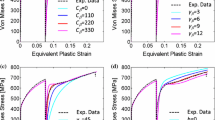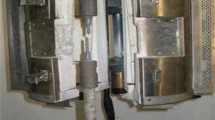Abstract
A model of ductile failure of a body with a crack has been developed which enables predicting fracture toughness on the upper shelf of the fracture toughness temperature dependence taking into account the influence of the stress state. The model is based on the physical-mechanical model of ductile failure which is controlled by the critical value εf reached by plastic strain at the crack tip ε ρ i . In this case it is assumed that both the ε ρ i value, which precedes the crack growth onset by the mechanism of pore coalescence, and the critical strain εf are functions of specific stress state parameters, namely: the critical strain is a function of the stress state triaxiality σ m /σ n (σ m is the hydrostatic stress, σ i is the stress intensity), and ε ρ i is a function of the parameter χ introduced, which is an explicit function of all three principal local stresses in the process zone at the crack tip and which defines the degree to which the stress state approaches the plane strain conditions for a body of specified thickness. The model developed has two modifications one of which enables predicting fracture toughness of large-size bodies from the results of testing only small cylindrical specimens without cracks (smooth and with a circular recess) and the other from the results of testing small cylindrical specimens and small specimens with a crack.
Similar content being viewed by others
References
V. T. Troshchenko, V. V. Pokrovsky, and V. G. Kaplunenko, “Prediction of fracture toughness for heat-resistant steels considering specimen dimensions. Report 1. The results of the experimental investigation,”Probl. Prochn., No. 1, p. 5–25 (1997).
G. S. Pisarenko and A. J. Krasowsky, “Analysis of kinetics of quasibrittle fracture of crystalline materials,” in: Mechanical Behaviour of Materials. Proc. Int. Conf. Mech. Behav. Mater., Kyoto (1971). Kyoto (1972), Vol. I, pp. 421–432.
R. O. Ritchie, J. F. Knott, and J. R. Rice, “On the relation between critical tensile stress and fracture toughness,”J. Mech. Phys. Solids,21, No. 6, 395–410 (1973).
R. O. Ritchie, W. L. Server, and R. A. Wullaert, “Critical fracture stress and fracture strain model for the prediction of lower and upper shelf toughness in nuclear pressure vessel steels,”Metall. Trans.,10A, No. 10, 1557–1570 (1979).
A. J. Krasowsky and G. Pluvinage, “Structure parameters governing fracture toughness of engineering materials,”Phys. Chem. Mech. Mater.,29, No. 3, 113–123 (1993).
M. Kikuchi and K. Yano, “Analysis of the HRR stress field at the three-dimensional crack tip (Analysis of CT and CTT specimens),”JSME, Int. J., Ser. I,13, No. 2, 179–185 (1990).
G. W. Wellamn, W. A. Sorem, R. H. Dodds, and S. T. Rolfe, “Specimen thickness effects for elastic-plastic CTOD toughness of an A36 steel,”WRC Bull., No. 328, 1–11 (1987).
W. A. Sorem, R. H. Dodds, and S. T. Rolfe, “An analytical and experimental comparison of rectangular and square CTOD fracture specimens of an A36 steel,”WRC Bull., No. 328, 12–23 (1987).
G. W. Wellman, W. A. Sorem, R. H. Dodds, and S. T. Rolfe, “Specimen thickness effects for elastic-plastic CTOD toughness of an A36 steel,”ASTM STP, No. 945, 535–554 (1988).
H. Braam and J. Prij, “A statistical evaluation of the thickness effect of SENB4 using the J-distribution along the crack front,” in: Struct. Mech. React. Tech.: Trans. 9th Int. Conf., (1987). Lausanne (1987), Vol. G., pp. 33–38.
W. Schmitt, D. Siegele, and T. Hollstein, “Numerical analysis of elastic-plastic mechanics experiments,” Proc. of the ECF Conference, 4.
R. H. Dodds, S. T. Rolfe, and G. Wellman, “Finite element predictions of J and CTOD for nonlinear fracture mechanics,” Proc. of the Int. Conf. on Finite Elements in Computer. Mechanics, Bombay, India (1985), pp. 909–922.
D. Siegele, “3D-crack propagation using ADINA,”Computers and Structures,32, No. 3, 639–645 (1989).
D. Aurich and E. Sommer, “The effect of constraint on elastic-plastic fracture,”Steel Res.,59, No. 8, 358–366 (1988).
K. Machida, M. Kikuchi, and H. Mijamoto, “J-integral evaluation of side-grooved CCT specimens by three-dimensional analysis,”Int. J. ASME,32, No. 3, 355–361 (1989).
E. Moyer and H. Liebowits, “Effect of specimen thickness on crack front plasticity characteristics in three-dimensions,”Adv. Fract. Res.,2, 889–896 (1984).
H. Braam, “Evaluation of the Finite Element Analysis of the Three and Four Point Bending Specimens Tested in the NIL-Fracture Program,” EcN-86-136 (1986).
I. R. Dixon, “Stress and strain distributions around cracks in sheet material having various work-hardening characteristics,”J. Fract. Mech.,224, No. 1, 224–244 (1965).
W. R. Andrews and C. F. Shih, “Thickness and side groove effects on J-and resistance curves for A533B steel at 93°C,”ASTM STP, No. 668, 426–450 (1979).
G. Knauf and H. A. Riedel, “Comparative study on different methods to measure the crack opening displacement,”Adv. Fract. Res. Prep. 5th Int. Conf. Fract., Cannes (1981), Vol. 5, pp. 2547–2553.
G. P. Gibson and S. G. Druce, Metallurgy Division AERE Harwell, Report 10906 (1983).
H.-J. Kaizer, K. E. Hagedorn, and O. Pawelski, “Investigations on the influence of specimen geometry on stable crack front,”Arch. Eisenhuttenwes,55 No. 7, 339–343 (1984).
H. Kobayashi, H. Nakamura, and H. Nakazava, “ASTM STP, No. 803, vol. 11, 420–438 (1983)
G. P. Gibson, S. G. Druce, and C. E. Turner, “Effect of specimen size and geometry on ductile crack growth resistance in a Cr−Mn steel,”Int. J. Franct.,32, 219–240 (1987).
D.-Z. Sun, D. Dormagen, and W. Dahl, “Influence of specimen geometry on fracture mechanics values at the onset of stable crack extention,”Steel Res.,56, No. 8, 445–449 (1985).
J. Knott,Fundamentals of Fracture Mechanics [in Russian translation], Metallurgiya, Moscow (1978).
D. Broek,Fundamentals of Fracture Mechanics [in Russian translation], Vysshaya Shkola, Moscow (1980).
J. I. Bluhm, “A Model for the effect of thickness on fracture toughness,”ASTM Proc.,61, 1324–1331 (1961).
S. E. Kovchic and E. M. Morozov, “Characteristics of short-term fracture toughness of materials and methods of its determination,” in:Fracture Mechanics and Strength of Materials [in Russian]. Handbook in 4 volumes, Vol. 3, Ed. V. V. Panasyuk, Naukova Dumka, Kiev (1988).
D. Broek and H. Vlieger, The Thickness Effect in Plane Stress Fracture Toughness, Nat. Aerospace Inst., Amsterdam, Rept. 74032 (1974).
W. E. Anderson, Some Designer-Oriented Views on Brittle Fracture, Battelle Northwest Rept. SA-2290 (1969).
G. S. Neshpor, G. D. Kudryavtrseva, and L. I. Byakov, “Influence of methods for plastic zone size determination on the characteristics of the static fracture toughness,”Zavod. Lab., No. 7, 66–68 (1990).
GOST 25.506-85. Strength Calculations and Tests. Methods of Mechanical Testing of Materials. Determination of the Characteristics of Crack Growth Resistance (Fracture Toughness) under Static Loading [in Russian], Izdat-vo Standartov, Moscow (1985).
J. W. Hutchinson, “Singular behaviour at the end of a tensile crack in a hardening material,”J. Mech. Phys. Solids,16, No. 1, 13–31 (1968).
J. R. Rice and G. F. Rosengren, “Plane strain deformation near the crack tip in power-law hardening materials,”J. Mech. Phys. Solids,16, No. 1, 1–12 (1968).
W. H. Tai, “Approximate calculation of fracture ductility and fracture toughness of ductile metals,”Mater. Sci. Eng., A122, 205–210 (1989).
D. Zh. Sun, “Einfluss des Spannungzustandes und des Gefueges auf die Kennwerte der elastisch-plastischen Bruchmechanik,” Rheinisch-Westfallische technische Hochschule, Aachen, BRD.
V. V. Panasyuk, A. E. Andreikiv, and V. Z. Parton, “Fundamentals of the Fracture Mechanics of Materials,” in:Fracture Mechanics and Strength of Materials [in Russian]. Handbook in 4 volumes, Vol. 1, Ed. V. V. Panasyuk, Naukova Dumka, Kiev (1988).
R. O. Ritchie and A. W. Thompson, “On macroscopic and microscopic analyses for crack growth toughness in ductile alloys,”Met. Trans.,16, No. 1-6, 233–248 (1985).
K. H. Schwalbe, “On the influence of metallic materials,”Eng. Fract. Mech.,9, 795–832 (1977).
R. O. Ritchie, “Micro-Fracture Mechanics,”Met. Hardl.,8, 465–468 (1985).
T. Kobayashi, “Ductility of Materials and Methods of its Evaluation,”Nippon Kinzoku Gakkai Kaiho,27, No. 8, 664–670 (1988).
Zh. Xiulin, “On an United Model for Predicting Notch Strength and Fracture Toughness of Metals,”Eng. Fract. Mech.,33, No. 5, 685–695 (1988).
R. K. Pandey and S. Banerjee, “Strain induced fracture in low strength steels,”Ibid.,, 10, 817–829 (1978).
S. Jun, D. Zengjie, and L. Zhonghua, “Effect of stress triaxiality in crack tip field on validity of J-dominance,”Ibid.,,34, No. 3, 637–643 (1989).
S. Jun, D. Zengjie, and L. Zhonghua, “Constraint intensity in crack tip field and elastic-plastic fracture criterion,”Ibid.,,34, No. 2, 413–418 (1989).
S. Jun, D. Zengije, and T. Mingjing, “Plant stress elastic-plastic fracture criteria and constraint intensity in crack tip regions,”Ibid.,,37, No. 3, 675–680 (1992).
S. Jun, D. Zengije, L. Zhonghua, and T. Mingjing, “Stress triaxiality in crack tip regions of bend specimens with different crack-depth and fracture criterion at initiation,”ibid.,,36, No. 2, 321–326 (1991).
Author information
Authors and Affiliations
Additional information
Translated from Problemy Prochnosti, No. 2, pp. 5–19, March–April, 1997.
Rights and permissions
About this article
Cite this article
Troshchenko, V.T., Pokrovsky, V.V. & Kaplunenko, V.G. Prediction of fracture toughness for heat-resistant steels considering specimen dimensions. Report 2. Ductile fracture. Strength Mater 29, 105–115 (1997). https://doi.org/10.1007/BF02767585
Received:
Issue Date:
DOI: https://doi.org/10.1007/BF02767585




